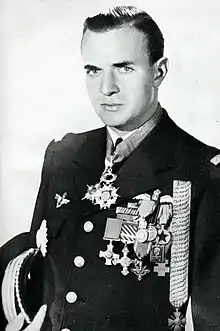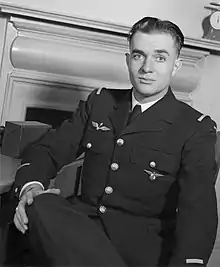Pierre-Henri Clostermann | |
|---|---|
 Pierre Clostermann, c. 1945. | |
| Born | 28 February 1921 Curitiba, Brazil |
| Died | 22 March 2006 (aged 85) Montesquieu-des-Albères, France |
| Allegiance | |
| Service/ | |
| Years of service | 1942–1945, 1956–1957 |
| Rank | Wing Commander (RAF) Lieutenant (France) |
| Unit | No. 341 Squadron RAF No. 602 Squadron RAF No. 274 Squadron RAF No. 56 Squadron RAF No. 3 Squadron RAF |
| Battles/wars | World War Two Algerian War |
| Awards | See List |
| Other work | Author, engineer and politician. |
| Website | pierre.clostermann.org |
Pierre-Henri Clostermann DSO, DFC & Bar (28 February 1921 – 22 March 2006) was a World War II French ace fighter pilot.
During the conflict he achieved 33 air-to-air combat victories, earning the accolade "France's First Fighter" from General Charles de Gaulle. His wartime memoir, The Big Show (Le Grand Cirque) became a notable bestseller. After the war, he worked as an engineer and was the youngest Member of France's Parliament.
Early life between Brazil, France and the USA
Clostermann was born and raised in Curitiba, Brazil, into a French diplomatic family. He was the only son of Madeleine Carlier from Lorraine and Jacques Clostermann from Alsace. He is perfectly fluent in Portuguese. There, he met French superstars of the time Jean Mermoz and Henri Guillaumet, then Aéropostale pilots. In 1935, he received his first flight on the seaplane Latécoère 521 "Lieutenant de Vaisseau Paris" on the Lac de Biscarrosse in South West France. In 1937, at the age of sixteen, he learned to fly at the Brazilian flying club in Manguinhos on Bücker Bü 131 Jungmann and Bü 133 Jungmeister with German pilot Karl Benitz (died in 1943, Russia). After receiving flying tuition , he completed his secondary education in France and gained his private pilot's licence in 1937. In 1937, he studied at the Franco-Brazilian high school Molière, in Rio de Janeiro. At the same time, he began writing columns for the newspaper Correio da Manhã. From 1938 to 1940, he took aeronautical engineering courses at the Ryan School of Aeronautics in San Diego, in the United States of America[1]. In 1940, he obtained his aeronautical engineering diploma and his professional pilot's license. He then joined England, via Brazil, Uruguay and South Africa, to join the Free French Air Force. He already had 315 flight hours under his belt.
World War II
On the outbreak of war in 1939 the French authorities refused his application for service, so he travelled to Los Angeles to become a commercial pilot, studying at the California Institute of Technology.[2] Clostermann joined the Free French Air Force in the United Kingdom in March 1942. After training at RAF Cranwell and 61 OTU, Clostermann, a sergeant pilot, was posted in January 1943 to No. 341 Squadron RAF (known to the Free French as Groupe de Chasse n° 3/2 "Alsace"), flying the Supermarine Spitfire.
On 15 July 1943 he crash-landed after combat when unable to lower his undercarriage (Cat.B). He scored his first two victories on 27 July 1943, also as Yellow 2, claiming destruction of two Focke-Wulf Fw 190s over France. In October 1943, Clostermann received a commission as an officer, and was assigned to the British No. 602 Squadron RAF, remaining with the unit for the next ten months. He flew a variety of operations including fighter sweeps, bomber escorts, high-altitude interdiction over the Royal Navy's Scapa Flow base, and strafing or dive-bombing attacks on V-1 launch sites on the French coast. He flew air-cover for the Normandy Landings, and was one of the first Free French pilots to land on French soil, at temporary airstrip B-11, near Longues-sur-Mer, Normandy on 18 June 1944. He was awarded the Distinguished Flying Cross shortly afterwards, after which he was reassigned to French Air Force Headquarters.

In December 1944 he returned to the front line on re-secondment to the Royal Air Force as a supernumerary flight lieutenant. He joined No. 274 Squadron RAF flying the new Hawker Tempest Mk V. In an aircraft which he named Le Grand Charles, Clostermann flew an intensive and highly successful round of fighter sweeps, airfield attacks, "rat scramble" interceptions of Messerschmitt 262 jet fighters, and rail interdiction missions over northern Germany over the next two months.
In March 1945 he briefly served with No. 56 Squadron, before transfer to No. 3 Squadron. On 24 March 1945 he was wounded in the leg by German flak, and after belly-landing his badly damaged aircraft was hospitalised for a week. From 8 April 1945 he was commander of "A" Flight, No. 3 Squadron RAF. He was awarded a bar to his DFC. He was later promoted to Wing Commander (flying) of 122 Wing, the most prestigious wing in the R.A.F., at the age of 24.
On 12 May 1945 during a victory fly-past to mark the war's conclusion, another Tempest collided with his, and as a result an air pile-up occurred with four close formation low-flying aeroplanes of his flight involved, with three pilots being killed. Clostermann bailed out, his parachute opening just a few metres above the ground. He continued operations with No. 122 Wing RAF until he left the military altogether on 27 July 1945 with the RAF rank of wing commander and the French rank of lieutenant.
In his 432 sorties, Clostermann was credited officially with 33 victories (19 solo, 14 shared, most of them against fighters) and five "probables", with eight more "damaged". He also claimed 225 motor vehicles destroyed, 72 locomotives, five tanks, and two E-boats (fast torpedo boats). Many references credit him with 29 to 33 victories, although these probably include his "ground" kills of enemy aircraft. Recent, more detailed analysis of his combat reports and squadron accounts indicate that his actual score was 11 destroyed, with possibly another seven, for a total of 15–18 victories.[3][4]
Later life
In 1951, Clostermann authored an account of his wartime experiences entitled Le Grand Cirque (published in English as The Big Show). One of the first post-war fighter pilot memoirs, its various editions have sold over two and a half million copies.[5] William Faulkner commented that this is the finest aviation book to come out of World War II. The book was reprinted, in expanded form, in both paperback and hardcover editions in 2004. It was also adapted in comic book form by Manuel Perales, in close collaboration with Clostermann.[6] Clostermann also wrote Feux du Ciel (Flames in the Sky) published in 1957, a collection of heroic air combat exploits from both Allied and Axis sides.
After the war, Clostermann continued his career as an engineer, participating in the creation of Reims Aviation, supporting the Max Holste Broussard prototype, acting as a representative for Cessna, and working for Renault.[7]
He served eight terms as a député (member of parliament) in the French National Assembly between 1946 and 1969.[7] As a deputy for Marne he resigned from the Gaullist group in 1955 over their treatment of the Resident-General in French Morocco during the negotiations with nationalist movement.[8]
He also briefly re-enlisted in the Armée de l'Air in 1956–57 to fly ground-attack missions during the Algerian War. He subsequently published a novel based on his experiences there, entitled Leo 25 Airborne.
During the Falklands War in early 1982 comments publicly emerged from Clostermann expressing praise for the courage displayed by Argentine Air Force and Argentine Navy pilots during their air-to-sea attacks on the Royal Navy.[9] Clostermann had written the comments, which were partly motivated by ethnic insults towards Argentinians that he had become aware of in the British press during the conflict, in a letter to a class of Argentine fighter-pilots who were being trained at that time in France at an Armée de l'Air establishment, at which his son was an instructor. The private letter's comments, from a renowned World War II military hero, swiftly found their way across the Atlantic Ocean to Buenos Aires, where they were published in newspapers as war propaganda.[10] As a result of this perceived "betrayal" of his links with the United Kingdom via his war service in the Royal Air Force, Clostermann attracted hostility from parts of the British press.
He also attracted controversy in France for his vehement anti-war stance in the run-up to the 1991 Gulf War.
Death
Clostermann died on 22 March 2006 at his home at Montesquieu-des-Albères, in the French Pyrenees.[11]
Private life
While serving in Lincolnshire, Pierre met and married Lydia Jeanne Starbuck at St Denys Church in Sleaford on the 28th of April 1943.
Clostermann was married and had three sons.
Honours
On 6 June 2004, a road in Longues-sur-Mer, near temporary airstrip B-11, was named after Clostermann.
French decorations
Foreign orders and decorations
References
Notes
- ↑ Christophe Cony, « Pierre Clostermann : L’instinct du chasseur », Avions, no 227, janvier-février 2019, p.7
- ↑ "Obituary: Pierre Clostermann" (PDF). Graduate Aerospace Laboratories of the California Institute of Technology. 6 April 2006. Archived from the original (PDF) on 8 October 2011. Retrieved 1 July 2016.
- ↑ Shores and Williams 1994, p. 180.
- ↑ Thomas 1999, p. 86.
- ↑ Wings Encyclopedia of Aviation p. 593.
- ↑ "Manuel Perales". Lambiek Comiclopedia. Retrieved 21 June 2018.
- 1 2 "Pierre Henri Clostermann". Assemblée nationale (in French). Retrieved 1 July 2016.
- ↑ "From Our Own Correspondent. "Tanks Hunt Rebels."". The Times. No. 53309. 26 August 1955. p. 6. Retrieved 30 September 2023 – via The Times Digital Archive.
- ↑ "Reconocimientos" [Acknowledgements]. Fuerza Aérea Argentina (in Spanish). Archived from the original on 19 November 2015. Retrieved 1 July 2016.
- ↑ Letter from Clostermann to 'Scale Aircraft Modelling' magazine, May 2000. https://groups.google.com/forum/#!topic/rec.aviation.military/YEgQZ4p6y1k
- ↑ "Pierre Clostermann". Daily Telegraph. 25 March 2006.
Bibliography
- Clostermann, Pierre. The Big Show. (Translated by Oliver Berthoud) London: Weidenfeld & Nicolson, 2004. ISBN 0-297-84619-1.
- Clostermann, Pierre (October 2001). "Pierre Clostermann nous écrit" [Pierre Clostermann Writes Us]. Avions: Toute l'Aéronautique et son histoire: Tout le monde descende! (in French) (103): 18–22. ISSN 1243-8650.
- Cony, Christophe (July 2001). "Pierre Clostermann: le "première chasseur de France"" [Pierre Clostermann: "The First Hunter of France"]. Avions: Toute l'Aéronautique et son histoire (in French) (100): 2–9. ISSN 1243-8650.
- "Courrier des Lecteurs" [Readers' Letters]. Avions: Toute l'Aéronautique et son histoire (in French) (101): 5. August 2001. ISSN 1243-8650.
- Shores, Christopher and Clive Williams. Aces High. London: Grub Street, 1994. ISBN 1-898697-00-0.
- Thomas, Chris. Typhoon and Tempest Aces of World War 2. Aircraft of the Aces No. 27. Botley, Oxford, UK: Osprey Publishing, 1999. ISBN 1-85532-779-1.
- Wings Encyclopedia of Aviation. London: Orbis Publishing, 1979.